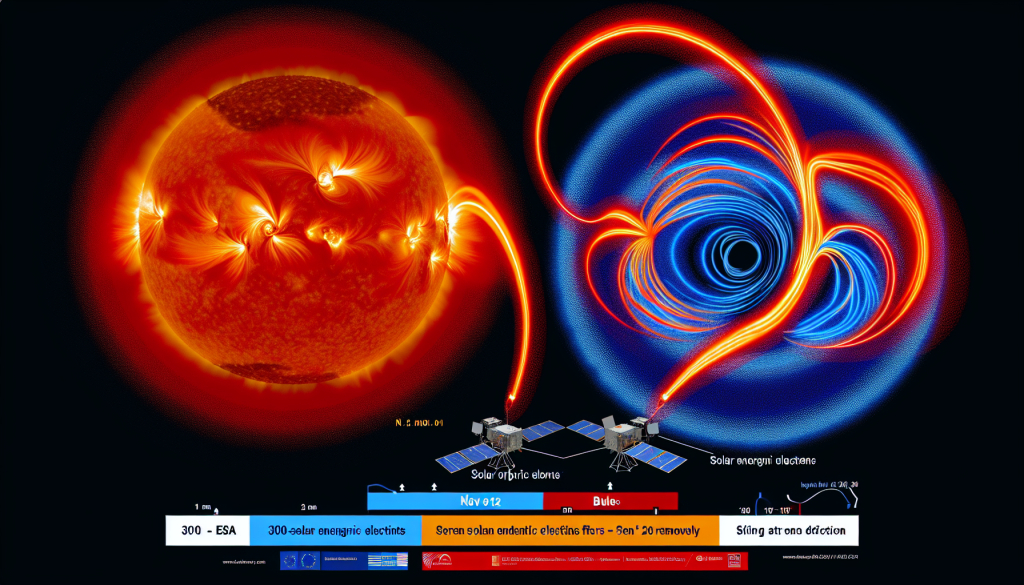Solar Orbiter tracks high-speed electrons to their solar source

Image:
Between November 2020 and December 2022, the Solar Orbiter spacecraft recorded over 300 instances of high-energy electron emissions originating from the Sun.
This is the first time scientists have been able to directly link these energetic electrons in space to specific solar events on the Sun itself.
These electrons are emitted by two different phenomena: solar flares, which produce short, intense bursts of energy, and coronal mass ejections (CMEs), which result in a broader, steadier release of electrons.
This breakthrough, now published in the journal Astronomy & Astrophysics, introduces a comprehensive public database cataloging these events as documented by the Solar Orbiter mission.
Credit: ESA & NASA/Solar Orbiter/STIX & EPD
The European Space Agency’s Solar Orbiter mission, with assistance from NASA, has classified the high-energy particles emitted by the Sun into two distinct categories, tracing each to specific solar eruptions.
The Sun, being the Solar System’s most powerful natural particle accelerator, propels electrons at near-light speeds across space, filling our environment with what scientists call ‘Solar Energetic Electrons’ (SEEs).
Using advanced instruments aboard Solar Orbiter, researchers determined the sources of these electrons and established a direct connection between observations in space and solar activities. A study in Astronomy & Astrophysics highlights that one category of SEEs stems from solar flares, while the other is tied to massive gas eruptions in the form of CMEs.
Lead author Alexander Warmuth, from the Leibniz Institute for Astrophysics Potsdam in Germany, explains, “We see a clear division between impulsive events from solar flares and gradual ones linked to CMEs, each releasing electrons in very distinct ways.”
Sharper Insights
Although scientists had previously assumed there were different types of SEE events, Solar Orbiter’s ability to observe numerous occurrences at varying distances from the Sun provided new insights into how these particles are accelerated and ejected.
Alexander adds, “Only Solar Orbiter could provide measurements from so close to the Sun, allowing us to track the electrons back to their origins and understand when and where they were produced.”
Delays in Emissions
By detecting these events at multiple points in the Solar System, researchers explored how energetic electrons move through space and why there appears to be a delay between solar eruptions and the arrival of these particles.
Co-author Laura Rodríguez-García, an ESA research fellow, noted, “Some particles seem delayed due to complex travel paths—disturbances along the way scatter and redirect them, so they don’t all arrive at once.”
Space between the Sun and planets is not empty—it’s filled with solar wind, a stream of charged particles accompanied by magnetic fields. This environment alters the motion of high-energy particles, slowing and diverting their path as they travel outward.
This study accomplishes a major goal of the Solar Orbiter mission: continuously observe the Sun and track the movement of ejected particles from their point of origin.
“Solar Orbiter is revolutionizing our understanding of the Sun,” says ESA Project Scientist Daniel Müller. “In just five years, it has collected data on a large number of energetic electron events, laying the groundwork for future study through a detailed and accessible database.”
Protecting Satellites and Astronauts
This discovery is particularly significant for space weather forecasting. Of the two types of SEE events, those associated with CMEs pose a greater threat as they carry more energy and can cause more serious damage to satellites and space missions.
“Thanks to Solar Orbiter’s findings, we can begin to better predict when and what kind of solar events might pose a threat to our technology and astronauts,” says Müller. “This achievement showcases the value of joint collaboration, made possible by contributions from European institutions and international partners.”
Looking to the future, ESA plans to launch the Vigil mission in 2031. This satellite will monitor the Sun’s lateral regions, providing early warnings about solar activity before such events rotate into Earth's view.
Additionally, ESA's upcoming Smile mission will further explore how Earth interacts with the solar wind, observing how these solar particles engage with Earth's magnetic field and impact our environment.
The Solar Orbiter mission reflects a partnership between ESA and NASA and is operated by ESA.
Editor’s Note:
'CoSEE-Cat: a Comprehensive Solar Energetic Electron event Catalogue obtained from combined in-situ and remote-sensing observations from Solar Orbiter' by A. Warmuth et al. is featured in the journal Astronomy & Astrophysics. The event data is openly shared in a dedicated catalog titled CoSEE-Cat.
Journal
Astronomy and Astrophysics
DOI
10.1051/0004-6361/202554830
Method of Research
Observational study
Subject of Research
Not applicable
Article Title
CoSEE-Cat: a Comprehensive Solar Energetic Electron event Catalogue obtained from combined in-situ and remote-sensing observations from Solar Orbiter
Article Publication Date
1-Sep-2025


